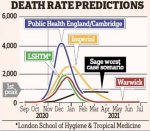PNWokingham
Journeyman Pro
I am not missing the point at all, you cited Sweden as an example of things being done better, and I refuted it. People need to get off this false idea that Sweden had a good lockdown. They didn't. They had a disaster. Their situation is, in many ways, not comparable to us but if you think it is, so too are New Zealand or South Korea. They locked down hard and had much better case and death rates than either the UK or Sweden.
Now you are switching to an unsubstantiated point that the effects on deaths and the economy is worse than Covid, and are getting exponentially worse. Is that taking the piss, using the term used to describe pandemic growth? In any case, it simply isn't true. The economic effects would have been much less had effective and swift control been applied in a timely manner to Covid. That is the lesson of history seen in previous pandemics. Instead we have seen an utter [banned word] show, and failing to control things now will only prolong matters.
The lunatic plans for herd immunity advocated by the American libertarians funding the Great Barrington Declaration will not work, but will cost tens or hundreds of thousands of lives while failing. It is utterly irresponsible, if not criminal. It will also take a long time to play out, during which the NHS will be overwhelmed, unless there is also a plan for lime pits to push the bodies into instead. Plenty of cancer patients will die while the hospitals are packed full of the victims of herd immunity.
There is clearly an adverse effect of Covid on other aspects of the NHS, and I know plenty of people working their arses off to reduce it. I know for a fact that you can get face to face doctors appts if one is needed, my wife is one such doctor who offers them, and I know plenty of doctors in frontline specialties across the board who are likewise working hard to keep things going in difficult circumstances. I don't know, nor want to know, anything about your family's situation or whether face to face was really needed, but regardless I don't think you can extrapolate their experience to the whole country's NHS experience.
This pandemic is having effects on all of us, and in some cases they are very bad effects, but magical thinking ain't going to fix it.
and i will bite my tongue at your aggressive, judgemental, superior bullying attitude. And will not respond to you again. You have a shocking attitude. Go preach elsewhere.


